Spatiotemporal Variation Characteristics of Ecosystem Carbon Storage in Henan Province and Future Multi-Scenario Simulation Prediction
Abstract
:1. Introduction
2. Materials and Methods
2.1. General Situation of Henan
2.2. Data Sources
2.3. Research Method
2.3.1. PLUS Model
2.3.2. InVEST Model
2.3.3. Scenario Settings
3. Result and Analysis
3.1. PLUS Model Verification
3.2. Land Use in Henan Province
3.2.1. Current Situation of Land Use in Henan Province
3.2.2. Prediction of Land Use and Cover under Different Scenarios in Henan Province in the Future
3.3. Carbon Storage in Henan Province
3.3.1. Variation Characteristics of Carbon Storage in Henan Region
3.3.2. Prediction of Carbon Storage in Henan under Different Scenarios in the Future
3.4. The Relationship between Land Use Change and Carbon Storage
4. Discussion
5. Conclusions
- During the 2000 to 2020 period, farmland in Henan showed a decreasing trend, water area and construction land showed a steady growth trend, grasslands showed a decreasing trend, and woodland showed first an increasing and then a decreasing trend. Overall, the carbon storage in Henan has been on an annual downward trend. The central and northern regions of Henan, with Zhengzhou as the main center, have low carbon storage, which is closely related to rapid economic development, urban location and transportation.
- From 2030 to 2050, based on the predicted land use and cover in Henan, it can be seen that under the normal development scenario, the area of farmland and woodland basically shows a continuous downward trend, while the area of construction land shows an annual upward trend. Under SSP2-RCP4.5 and SSP5-RCP8.5, there is an increasing trend of farmland and construction land.
- From 2030 to 2050, according to the predicted carbon storage in Henan Province, it can be seen that the decline trend of carbon storage in Henan Province is the smallest under the SSP2-RCP4.5 scenario, and the overall declining trend of carbon storage in the SSP1-RCP2.6 scenario is also the largest among the three scenarios. The downward trend of carbon storage in the SSP5-RCP8.5 scenario is in between.
Author Contributions
Funding
Data Availability Statement
Conflicts of Interest
References
- Han, C.Q.; Zheng, J.H.; Wang, Z.; Yu, W.J. Spatiotemporal variation and multi-scenario simulation of carbon storage in terrestrial ecosystems in Turpan-Hami Basin based on PLUS-InVEST model. Arid. Land Geogr. 2023. epub ahead of printing. [Google Scholar]
- Li, J.P. Research on Land Use Change and Ecosystem Carbon Storage Based on InVEST Model—Taking Xiong’an New Area as an Example. Master’s Thesis, Hebei Agriculture University, Baoding, China, 2021. [Google Scholar]
- Wang, X.K.; Feng, Z.W.; Ouyang, Z.Y. Vegetation carbon storage and density of forest ecosystems in China. Chin. J. Ecol. 2001, 13–16. [Google Scholar] [CrossRef]
- He, L.Q.; Liu, Q.; Wang, D.C.; Zhang, Z.H.; Xu, C.; Shi, M.Y. Estimation of soil organic carbon storage based on digital soil mapping technique. J. Appl. Ecol. 2021, 32, 591–600. [Google Scholar]
- Zhong, F.F.; Du, J.Q.; Zhu, X.Q.; Sun, B.Q.; Li, L.J.; Song, Z.B.; Wu, L.Y.; Chen, X.Y.; Zhai, G.Q. Carbon Storage Estimation and Spatial Pattern Analysis of Terrestrial Ecosystems in the Beijing-Tianjin-Hebei Region. Res. Environ. Sci. 2023, 36, 2065–2073. [Google Scholar]
- Wang, Z. Spatial and Temporal Dynamics of Forest Carbon Storage and Influencing Factors Based on CASA Model in Hangzhou. Master’s Thesis, Zhejiang A&F University, Hangzhou, China, 2022. [Google Scholar]
- Xu, Y.T. Temporal and Spatial Variation and Prediction of Carbon Storage in Zhongyuan Urban Agglomeration. Master’s Thesis, Zhengzhou University, Zhengzhou, China, 2022. [Google Scholar]
- Wu, Z.; Chen, X.; Liu, B.B.; Chu, J.; Peng, L. Research Progress and Application of InVEST model. Chin. J. Trop. Agric. 2013, 33, 58–62. [Google Scholar]
- Zaehle, S.; Bondeau, A.; Carter, T.R.; Cramer, W.; Erhard, M.; Prentice, I.C.; Reginster, I.; Rounsevell, M.D.; Sitch, S.; Smith, B.; et al. Projected changes in terrestrial carbon storage in Europe under climate and land-use change, 1990–2100. Ecosystems 2007, 10, 380–401. [Google Scholar] [CrossRef]
- Jing, Y.Q.; Zhang, F.; Zhang, Y. Change and prediction of the land use/cover in Ebinur Lake Wetland Nature Reserve based on CA-Markov model. Chin. J. Appl. Ecol. 2016, 27, 3649–3658. [Google Scholar]
- Zhang, F.; Tang, G.A.; Cao, M.; Yang, J.Y. Simulation of Positive and Negative Terrain Evolution in Small loess Watershed Based on ANN-CA Model. Geogr. Geo-Inf. Sci. 2013, 29, 28–31;+1. [Google Scholar]
- Jiang, W.; Deng, Y.; Tang, Z.; Lei, X.; Chen, Z. Modelling the potential impacts of urban ecosystem changes on carbon storage under different scenarios by linking the CLUE-S and the InVEST models. Ecol. Model. 2017, 345, 30–40. [Google Scholar] [CrossRef]
- Zhang, J.D.; Mei, Z.X.; Lv, J.H.; Chen, J.Z. Simulating Multiple Land Use Scenarios based on the FLUS Model Considering Spatial Autocorrelation. J. Geo-Inf. Sci. 2020, 22, 531–542. [Google Scholar] [CrossRef]
- Wang, X.; Ma, B.W.; Li, D.; Chen, K.; Yao, H. Multi-scenario simulation and prediction of ecological space in Hubei province based on FLUS model. J. Nat. Resour. 2020, 35, 230–242. [Google Scholar]
- Wang, X.; Wang, C.Y.; Lv, F.N.; Chen, S.L.; Yu, Z.R. Temporal and spatial carbon storage change and carbon sink improvement strategy of district and county level based on PLUS-InVEST model: Taking Yanqing District as an example. Chin. J. Applled Ecol. 2023, 34, 3373–3384. [Google Scholar]
- Wang, Z.H.; Wang, B.; Zhang, Y.F.; Zhang, Q.L. Dynamic simulation of multi-scenario land use change and carbon storage assessment in Hohhot city based on PLUS-InVEST model. J. Agric. Resour. Environ. 2023; Epub ahead of printing. [Google Scholar] [CrossRef]
- Liu, X.J.; Li, X.; Liang, X.; Shi, H.; Ou, J. Simulating the Change of Terrestrial Carbon Storage in China Based on the FLUS-InVEST Model. Trop. Geogr. 2019, 39, 397–409. [Google Scholar]
- Shi, J.; Shi, P.J.; Wang, Z.Y.; Cheng, F.Y. Spatial-Temporal Evolution and Prediction of Carbon Storage in Jiuquan City Ecosystem Based on PLUS-InVEST Model. J. Environ. Sci. 2024, 45, 300–313. [Google Scholar]
- Hu, J.X.; Le, X.W.; Wang, W.L.; Xiong, Y.; Tan, X.L. Temporal and Spatial Evolution and Prediction of Ecosystem Carbon Storage in Jiangxi Province Based on PLUS-InVEST Model. J. Environ. Sci. 2023; Epub ahead of printing. [Google Scholar] [CrossRef]
- Yu, Z.L.; Zhao, M.S.; Gao, Y.F.; Wang, T.; Zhao, Z.D.; Wang, S.H. Spatio-temporal Evolution and Prediction of Carbon Storage in Huaibei City Based on InVEST-PLUS Model. J. Environ. Sci. 2023; Epub ahead of printing. [Google Scholar] [CrossRef]
- Yue, S.; Ji, G.; Chen, W.; Huang, J.; Guo, Y.; Cheng, M. Spatial and Temporal Variability Characteristics of Future Carbon Stocks in Anhui Province under Different SSP Scenarios Based on PLUS and InVEST Models. Land 2023, 12, 1668. [Google Scholar] [CrossRef]
- Mao, Y.F.; Zhou, Q.G.; Wang, T.; Luo, H.R.; Wu, H.J. Spatial-temporal Variation of Carbon Storage and Its Quantitative Attribution in the Three Gorges Reservoir Area Couple with PLUS- InVEST -Geodector model. Resour. Environ. Yangtze Basin 2023, 32, 1042–1057. [Google Scholar]
- Li, X.; Wu, K.; Feng, Z.; Wang, Z.H. Carbon balance from the perspective of supply and demand of carbon sequestration services in Henan Province. Acta Ecol. Sin. 2022, 42, 9627–9635. [Google Scholar]
- Wang, Y.; Liu, L.; Shangguan, Z. Dynamics of forest biomass carbon stocks from 1949 to 2008 in Henan Province, east-central China. J. For. Res. 2018, 29, 439–448. [Google Scholar] [CrossRef]
- Xiao, D.; Niu, H.; Guo, J.; Zhao, S.; Fan, L. Carbon Storage Change Analysis and Emission Reduction Suggestions under Land Use Transition: A Case Study of Henan Province, China. Int. J. Environ. Res. Public Health 2021, 18, 1844. [Google Scholar] [CrossRef]
- Xu, X.; Liu, J.; Zhang, S.; Li, R.; Yan, C.; Wu, S.; China Multi-Period Land Use Remote Sensing Monitoring Dataset (CNLUCC). Resource and Environmental Science Data Registration and Publication System. 2018. Available online: https://www.resdc.cn/DOI/doi.aspx?DOIid=54 (accessed on 28 January 2024).
- Available online: https://openstd.samr.gov.cn/bzgk/gb/newGbInfo?hcno=224BF9DA69F053DA22AC758AAAADEEAA (accessed on accessed on 28 January 2024).
- Miao, Y.Y. Optimization and Simulation of County Land Use Change and Carbon Storage Based on FLUS and InVEST Models. Master’s Thesis, Shandong Agricultural University, Taian, China, 2023. [Google Scholar]
- Xu, L.; He, N.P.; Yu, G.R. A dataset of carbon density in Chinese terrestrial ecosystems (2010s). China Sci. Data 2019, 4, 90–96. [Google Scholar]
- Li, K.R.; Wang, S.Q.; Cao, M.K. Carbon storage of vegetation and soil in China. Sci. Sin. (Terrae) 2003, 33, 72–80. [Google Scholar] [CrossRef]
- Xie, X.L.; Sun, B.; Zhou, H.Z.; Li, Z.P. Organic carbon density and storage in soils of China and spatial analysis. Acta Pedol. Sin. 2004, 41, 35–43. [Google Scholar]
- Alam, S.A.; Starr, M. Biomass and soil carbon stocks of Sudanese Acacia savanna woodland. J. Arid. Environ. 2013, 89, 67–76. [Google Scholar] [CrossRef]
- Fan, L.; Cai, T.; Wen, Q.; Han, J.; Wang, S.; Wang, J.; Yin, C. Scenario simulation of land use change and carbon storage response in Henan Province, China: 1990–2050. Ecol. Indic. 2023, 154, 110660. [Google Scholar] [CrossRef]
- Zhang, L.X.; Chen, X.L.; Xin, X.G. Short commentary on CMIP6 Scenario Model Intercomparison Project (Scenario MIP). Clim. Chang. Res. 2019, 15, 519–525. [Google Scholar]
- Popp, A.; Calvin, K.; Fujimori, S.; Havlik, P.; Humpenöder, F.; Stehfest, E.; Bodirsky, B.L.; Dietrich, J.P.; Doelmann, J.C.; Gusti, M.; et al. Land-use futures in the shared socio-economic pathways. Glob. Environ. Chang. 2017, 42, 331–345. [Google Scholar] [CrossRef]
- Sun, Y.; Yang, J.; Song, S.; Zhu, J.; Dai, J. Modeling of multilevel vector cellular automata and its simulation of land use change. Acta Geogr. Sin. 2020, 75, 2164–2179. [Google Scholar]
- Ke, X.; Tang, L. lmpact of cascading processes of urban expansion and cropland reclamation on the ecosystem of a carbon storage service in Hubei Province, China. Acta Ecol. Sin. 2019, 39, 672–683. [Google Scholar]
- Sun, F.H.; Fang, F.M.; Hong, W.L.; Luo, H.; Yu, J.; Fang, L.; Miao, Y.Q. Evolution Analysis and Prediction of Carbon Storage in Anhui Province Based on PLUS and InVEST Mode. J. Soil Water Conserv. 2023, 37, 151–158. [Google Scholar] [CrossRef]
- Wang, Z.Y.; Wu, F.; Wan, D.; Zhang, K.; Li, L.; Huang, C.H. Multi-scenario simulation of the impact of regional land use change on carbon reserve. China Environ. Sci. 2023, 43, 6063–6078. [Google Scholar] [CrossRef]
- Wang, C.Y.; Guo, X.H.; Guo, L.; Bai, L.F.; Xia, L.L.; Wang, C.B.; Li, T.Z. Land use change and its impact on carbon storage in northwest China based on FLUS-Invest: A case study of Hu-Bao-Er-Yu urban agglomeration. Ecol. Environ. Sci. 2022, 31, 1667–1679. [Google Scholar]
- Liang, Y.; Hashimoto, S.; Liu, L. Integrated assessment of land-use/land-cover dynamics on carbon storage services in the Loess Plateau of China from 1995 to 2050. Ecol. Indic. 2021, 120, 106939. [Google Scholar] [CrossRef]
- Terra, M.C.; Nunes, M.H.; Souza, C.R.; Ferreira, G.W.; do Prado-Junior, J.A.; Rezende, V.L.; Maciel, R.; Mantovani, V.; Rodrigues, A.; Morais, V.A.; et al. The inverted forest: Aboveground and notably large belowground carbon stocks and their drivers in Brazilian savannas. Sci. Total Environ. 2023, 867, 161320. [Google Scholar] [CrossRef] [PubMed]
- Sun, B.; Du, J.; Chong, F.; Li, L.; Zhu, X.; Zhai, G.; Song, Z.; Mao, J. Spatio-Temporal Variation and Prediction of Carbon Storage in Terrestrial Ecosystems in the Yellow River Basin. Remote Sens. 2023, 15, 3866. [Google Scholar] [CrossRef]
- Lin, T.; Yang, M.Z.; Wu, D.F.; Liu, F.; Yang, J.H.; Wang, Y.J. Spatial correlation and preciction of land use carbon storage based on the InVEST-PLUS mode—A case study in Guangdong Province. China Environ. Sci. 2022, 42, 4827–4839. [Google Scholar] [CrossRef]

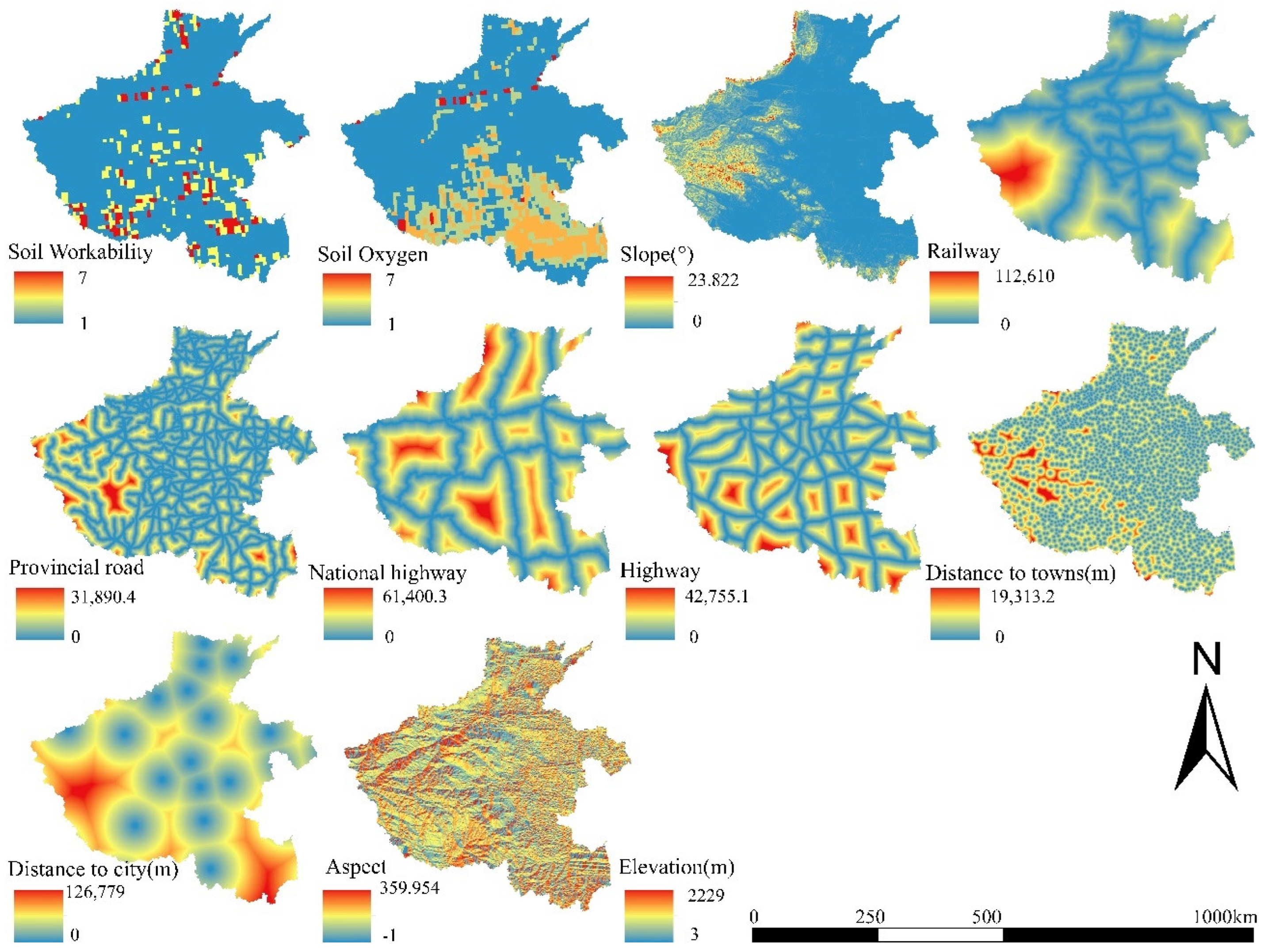
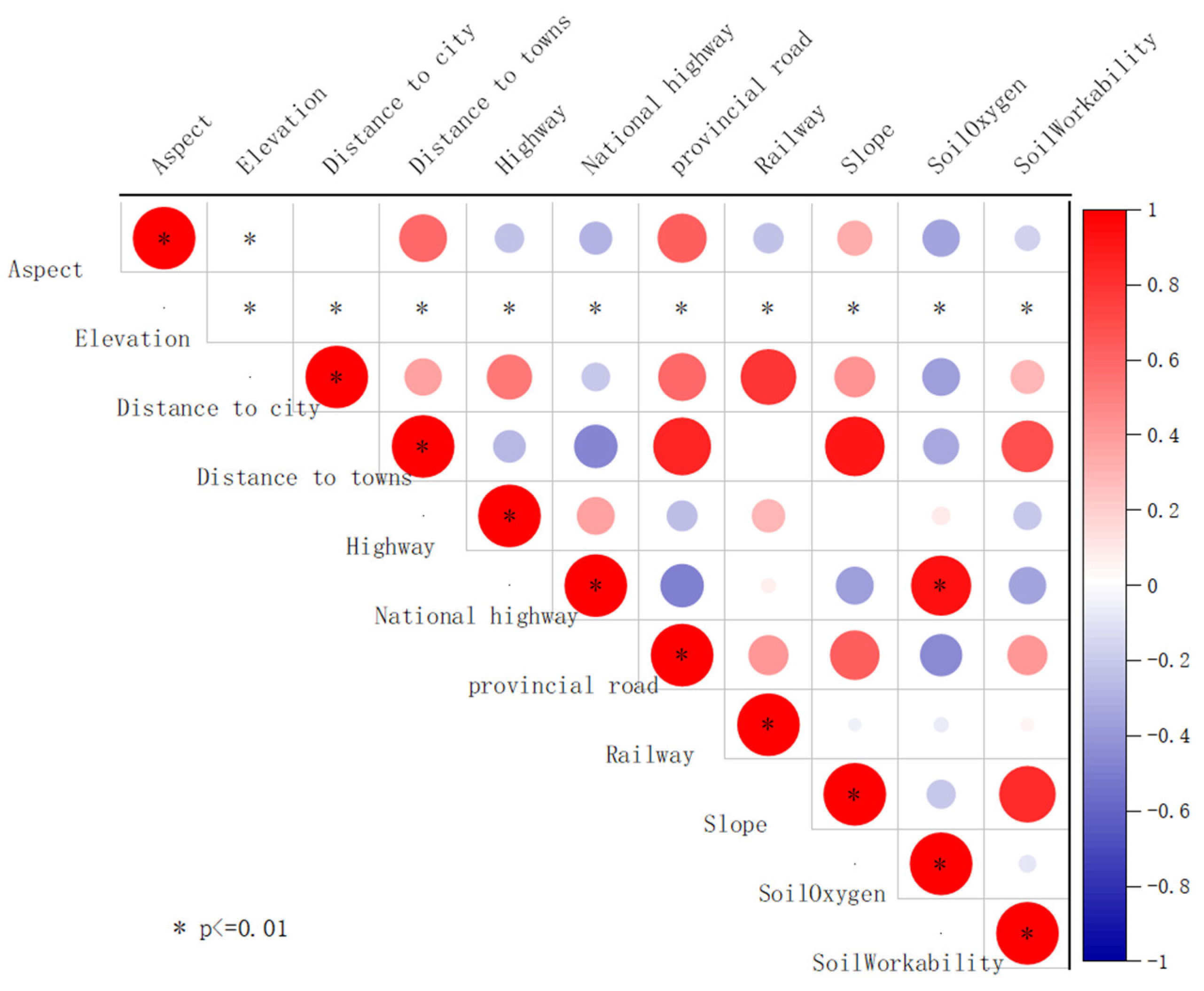

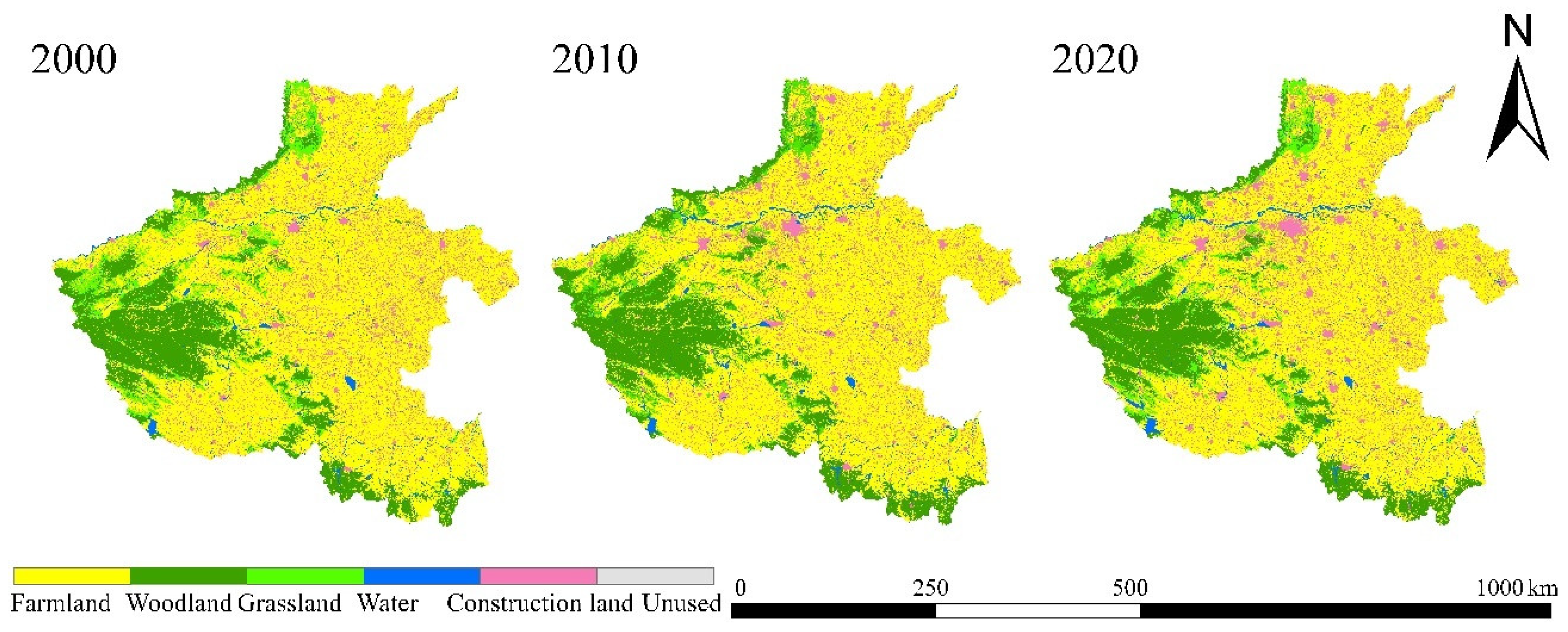
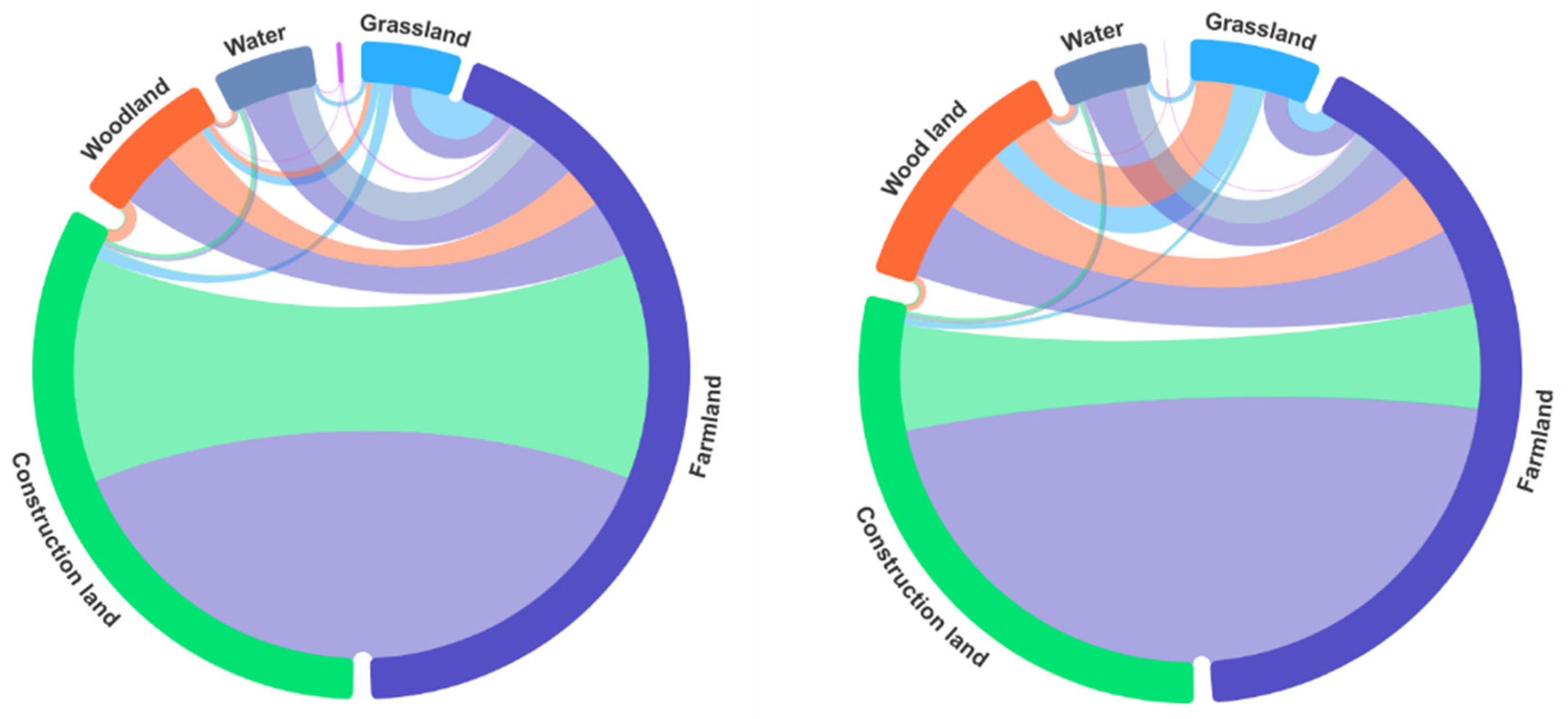

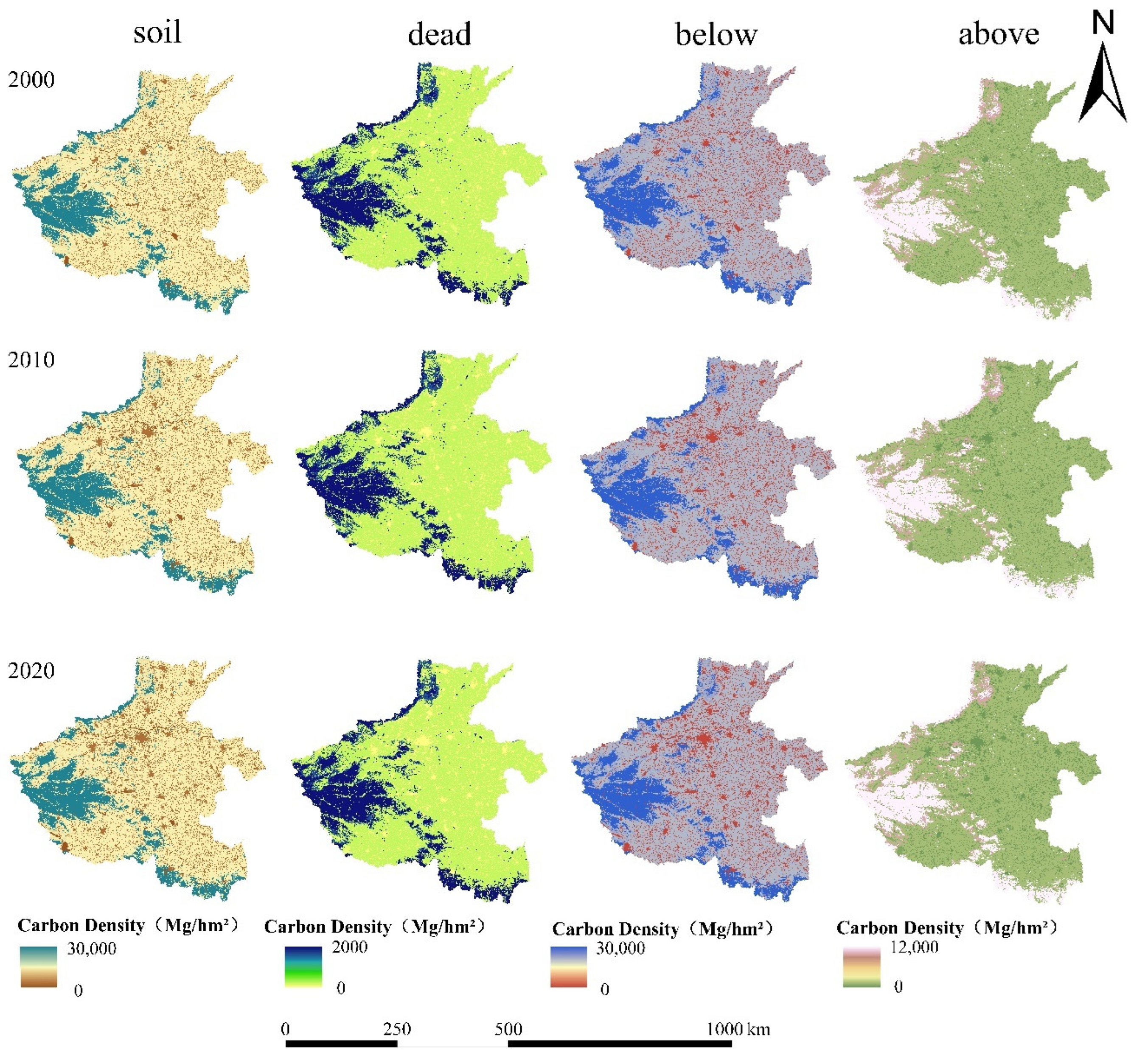
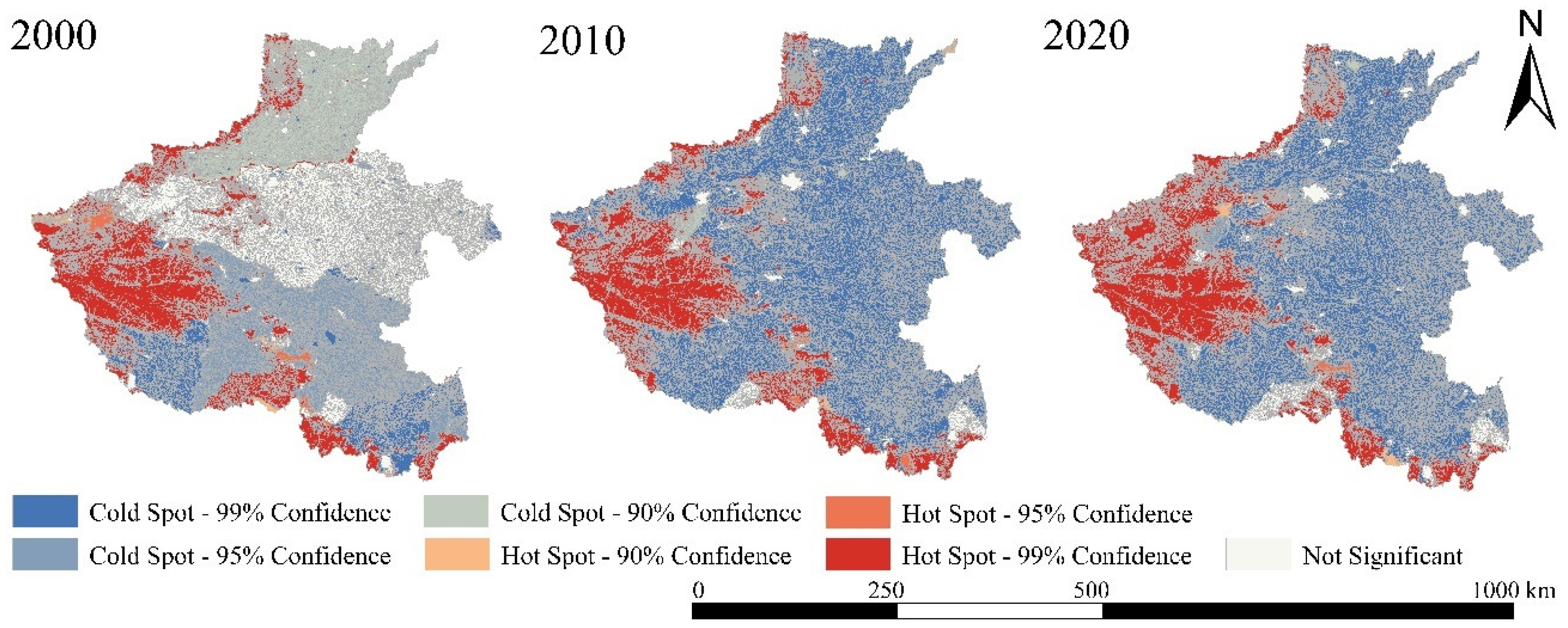
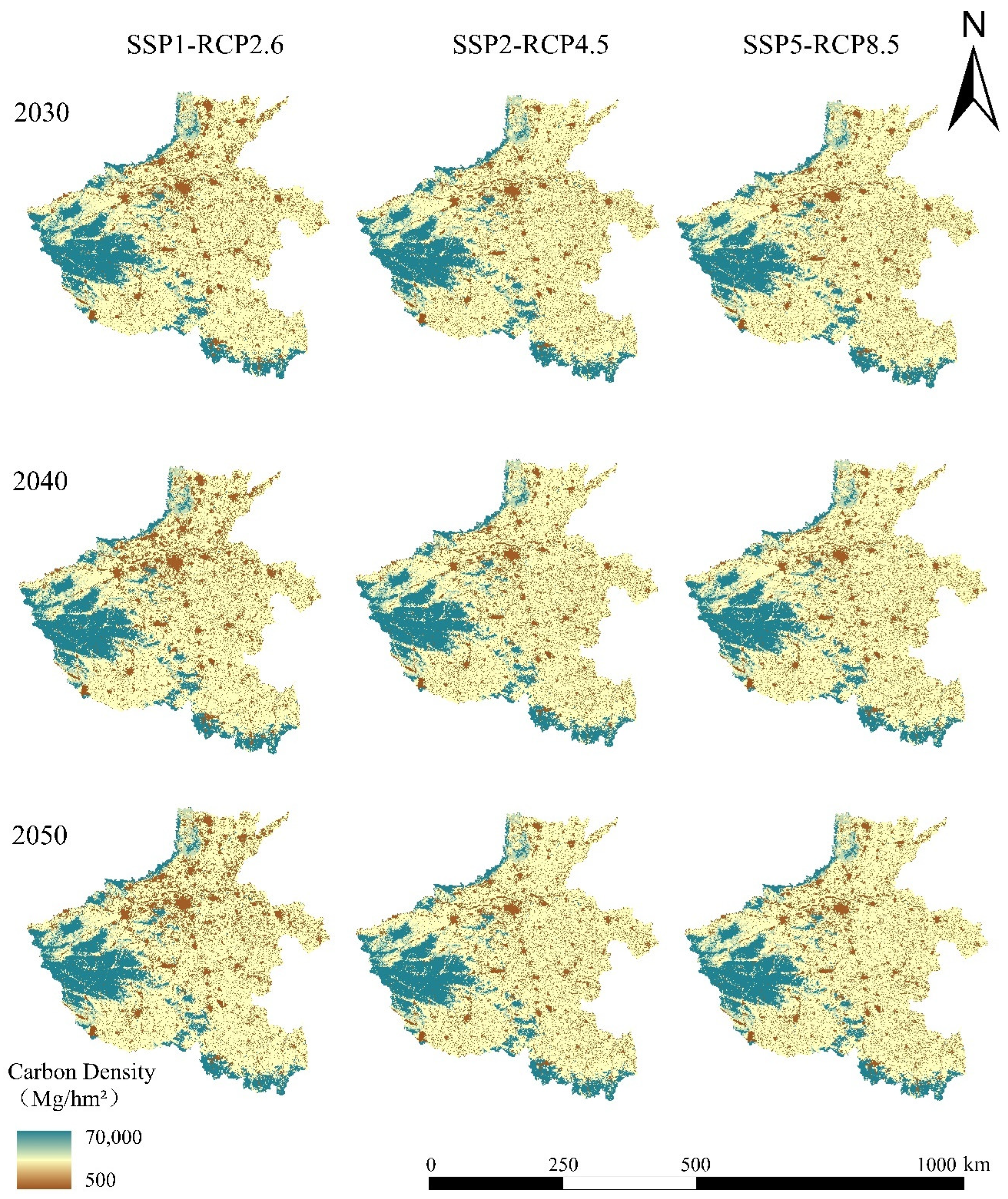

| Land Type | Soil | Dead | Below | Above |
|---|---|---|---|---|
| Farmland | 115.9 | 1.46 | 206.03 | 14.55 |
| Woodland | 253.29 | 10.82 | 295.9 | 108.25 |
| Grassland | 106.81 | 9.01 | 220.84 | 90.12 |
| Water | 0 | 0.77 | 0 | 7.66 |
| Construction land | 23.09 | 0.33 | 0 | 3.32 |
| Unused land | 0 | 0.64 | 0 | 6.38 |
| 2000 | 2010 | ||||||
|---|---|---|---|---|---|---|---|
| Grassland | Farmland | Construction | Woodland | Water | Unused | Total | |
| Grassland | 8540.15 | 613.62 | 209.26 | 127.47 | 62.29 | 4.00 | 9556.79 |
| Farmland | 312.98 | 101,066.61 | 5394.61 | 958.10 | 751.93 | 1.02 | 108,485.25 |
| Construction | 16.29 | 3733.69 | 13,355.24 | 20.19 | 52.51 | 0.00 | 17,177.92 |
| Woodland | 85.24 | 680.71 | 196.21 | 25,975.40 | 6.45 | 2.00 | 27,016.00 |
| Water | 13.26 | 427.91 | 62.49 | 32.46 | 3027.64 | 2.00 | 3565.76 |
| Unused | 1.00 | 32.03 | 2.00 | 13.99 | 19.00 | 15.98 | 84.00 |
| Total | 8968.92 | 106,554.57 | 19,219.81 | 27,127.61 | 3989.81 | 25.00 | 165,885.72 |
| 2010 | 2020 | ||||||
|---|---|---|---|---|---|---|---|
| Grassland | Farmland | Construction | Woodland | Water | Unused | Total | |
| Grassland | 8471.97 | 170.68 | 55.45 | 227.21 | 41.79 | 0.04 | 8967.14 |
| Farmland | 217.44 | 101,578.85 | 3637.33 | 711.64 | 389.15 | 2.08 | 106,536.49 |
| Construction | 13.20 | 970.65 | 18,192.45 | 17.00 | 25.96 | 0.00 | 19,219.25 |
| Woodland | 346.36 | 605.30 | 57.61 | 26,040.15 | 52.14 | 6.03 | 27,107.59 |
| Water | 10.13 | 200.38 | 33.97 | 35.24 | 3701.33 | 0.00 | 3981.06 |
| Unused | 0.03 | 7.07 | 0.02 | 3.01 | 1.03 | 13.83 | 24.99 |
| Total | 9059.14 | 103,532.92 | 21,976.83 | 27,034.25 | 4211.40 | 21.98 | 165,836.53 |
| Land Type | SSP1-RCP2.6 | SSP2-RCP4.5 | SSP5-RCP8.5 | ||||||
|---|---|---|---|---|---|---|---|---|---|
| 2030 | 2040 | 2050 | 2030 | 2040 | 2050 | 2030 | 2040 | 2050 | |
| Farmland | 10,151.5 | 10,063.1 | 9995.1 | 10,432 | 10,492 | 10,543.8 | 10,506 | 10,540.1 | 10,607.5 |
| Woodland | 2656.5 | 2661.5 | 2704.3 | 2685.1 | 2656.4 | 2649.2 | 2598.2 | 2594.2 | 2516.6 |
| Grassland | 835.9 | 785.5 | 779.1 | 793.7 | 740 | 687 | 811.9 | 763.5 | 756.9 |
| Water | 428.9 | 428.9 | 428.9 | 428.9 | 428.9 | 428.9 | 428.9 | 428.9 | 428.9 |
| Construction | 2488.6 | 2622.5 | 2654.1 | 2221.7 | 2244.1 | 2252.6 | 2216.4 | 2234.8 | 2251.6 |
| Unused | 3.3 | 3.2 | 3.2 | 3.3 | 3.3 | 3.2 | 3.3 | 3.2 | 3.2 |
| Year | Scenario | Total Carbon Storage | Decadal Difference |
|---|---|---|---|
| 2030 | SSP1-RCP2.6 | 5632.76 | −122.92 |
| SSP2-RCP4.5 | 5721.52 | −34.16 | |
| SSP5-RCP8.5 | 5696.08 | −59.60 | |
| 2040 | SSP1-RCP2.6 | 5588.30 | −44.46 |
| SSP2-RCP4.5 | 5700.30 | −21.22 | |
| SSP5-RCP8.5 | 5684.76 | −11.31 | |
| 2050 | SSP1-RCP2.6 | 5592.03 | 3.74 |
| SSP2-RCP4.5 | 5690.60 | −9.70 | |
| SSP5-RCP8.5 | 5653.32 | −31.45 |
Disclaimer/Publisher’s Note: The statements, opinions and data contained in all publications are solely those of the individual author(s) and contributor(s) and not of MDPI and/or the editor(s). MDPI and/or the editor(s) disclaim responsibility for any injury to people or property resulting from any ideas, methods, instructions or products referred to in the content. |
© 2024 by the authors. Licensee MDPI, Basel, Switzerland. This article is an open access article distributed under the terms and conditions of the Creative Commons Attribution (CC BY) license (https://creativecommons.org/licenses/by/4.0/).
Share and Cite
Li, M.; Zhang, J.; Gao, H.; Ji, G.; Li, G.; Li, L.; Li, Q. Spatiotemporal Variation Characteristics of Ecosystem Carbon Storage in Henan Province and Future Multi-Scenario Simulation Prediction. Land 2024, 13, 185. https://doi.org/10.3390/land13020185
Li M, Zhang J, Gao H, Ji G, Li G, Li L, Li Q. Spatiotemporal Variation Characteristics of Ecosystem Carbon Storage in Henan Province and Future Multi-Scenario Simulation Prediction. Land. 2024; 13(2):185. https://doi.org/10.3390/land13020185
Chicago/Turabian StyleLi, Meng, Jincai Zhang, Huishan Gao, Guangxing Ji, Genming Li, Lei Li, and Qingsong Li. 2024. "Spatiotemporal Variation Characteristics of Ecosystem Carbon Storage in Henan Province and Future Multi-Scenario Simulation Prediction" Land 13, no. 2: 185. https://doi.org/10.3390/land13020185





